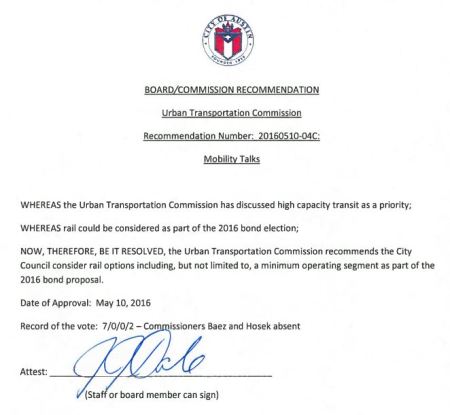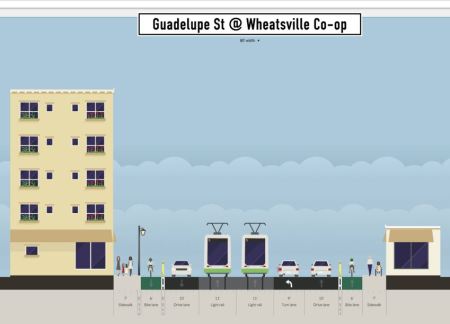
J.D. Gins, member of Urban Transportation Commission, at May 10th meeting, argues for recommendation to Austin City Council to include rail transit in November bond package. ARN screenshot from COA video.
♦
On May 7th, Austin voters resoundingly defeated Proposition 1, an effort by “gig” taxi firms Uber and Lyft to exempt themselves from several regulatory measures applying to other taxi services operating in Austin. In response, Uber and Lyft have both suspended their operations in Austin.
An interesting result is that interest has surged in the possibility of an urban rail alternative – mainly focused on an electric light rail transit (LRT) starter line for the Guadalupe-Lamar corridor – being added to a proposed package of “mobility” bond measures this coming November. In a May 12th news segment, for example, KXAN-TV News reporter Chris Sadeghi noted that “As Uber and Lyft leave the conversation on mobility options in Austin, it could provide urban rail the opportunity to re-enter it.”
At its regular meeting of May 10th, the City of Austin’s Urban Transportation Commission (UTC) unanimously passed a resolution presented by board member J.D. Gins (see photo at top of this post) recommending that “the City Council consider rail options including, but not limited to, a minimum operating segment as part of the 2016 bond proposal.” Reporting on this development, KXAN reporter Sadeghi interviewed UTC member Mario Champion. As Sadeghi related, “Because there have been studies and plans already conducted into the feasibility and design of rail projects, Champion said the commission is hopeful the process to getting an election item on the November ballot can move quickly.”
“We could dust off those plans and learn from the community what was good about them and what was not good about them” Champion told the reporter.

Resolution passed by Urban Transportation Commission recommends City Council consider including rail transit in November bond package. Screenshot by ARN from COA PDF. (Click to enlarge.)
Also covering the UTC recommendation for putting rail on the ballot, KEYE-TV News reporter Melanie Torre interviewed Andrew Clements with the Central Austin Community Development Corporation (CACDC). “Clements has been pushing for an urban light rail for years, but where the rail goes is critical to its success” reported Torre. Clements and the CACDC had played a key role in providing information on urban LRT for UTC members.
“All along North Lamar and Guadalupe there’s already density that would support light rail” Clements told Torre, adding “We’ve known since probably the 1970s that’s the best place to put light urban rail first.” Torre explained that “Years down the road, rail construction could expand north toward Rundberg Lane, east down Riverside Drive and south down Pleasant Valley Road.”
According to the KEYE report, CACDC is proposing a first segment that would “span from Crestview Station to Republic Square Park in downtown” at an estimated cost of about $465 million (2016 dollars). (The CACDC route replicates nearly 80% of the “Plan B” proposal described in an October 2014 ARN posting.)
“Even though it’s expensive, the most efficient way is what we need to start dedicating our public right-of-ways to …” Clements insisted. It should be noted, however, that this is a bargain price for such a mobility investment, which could potentially remove as many as 2,700 motor vehicles each peak hour from major arteries in the Guadalupe-Lamar corridor.
The $465 million investment cost also appears eminently affordable, if 50% Federal Transit Administration funding is assumed. Converting CACDC’s 2016 estimate to Year of Expenditure (YOE) dollars would imply a total project investment of $514 million over four years, and a local 50% match of $257 million – a budgetary allotment for Austin commensurate with other major capital investments in recent years.
A May 16th Austin Monitor article by Caleb Pritchard focused on the UTC vote and also put the urban rail possibility in the context of greater emphasis on alternative mobility opportunities, including expanded bicycle and pedestrian facilities. Pritchard notes that a funding package that would include the 2014 Bicycle Master Plan “as well as the construction of high-priority sidewalks around schools and transit stops” was already on the table in the amount of $411 million.
Miller Nuttle, representing Bike Austin, told the Monitor reporter: “I think rail should be a critical part of solving Austin’s long-term transportation crisis. I also think biking and walking are critical, too, and that’s something we can do now given that the plans have been thoroughly publicly vetted. All they need in order to be actualized is capital funding.”
Pritchard also quoted Clements in regard to the merits of CACDC’s $465 million proposal. “Of all the things that are being considered, I think light urban rail will have the most impact on mobility…” Clements stated. “I strongly support the bike master plan and the sidewalk plan, but I think that, at best, those are going to have single-digit impacts on ride-share mode splits. And I believe light urban rail will have the biggest bang for the buck.”
On May 17th, the City’s Zoning and Platting Commission included the UTC’s resolution “calling for funding the bicycle master plan, high priority sidewalks, and corridor plans that increase opportunities for high capacity transit, including the consideration of rail” in citing their basis to approve a resolution “calling on the city council to put a transportation bond proposal on the upcoming November ballot ….” according to a report from Fox 7 TV News.
Dick Kallerman, a longtime leader of the Travis County Sierra Club’s involvement in transportation issues, interviewed by Fox 7 News, suggested that “a better outreach campaign” might help convince more of the public to “get on board” with public transportation .
“If people start thinking in turns of urban, urban living, mass transit it part of it …” said Kallerman. ” If you get in a car it’s a contradiction, if you think you are an urbanite living in a city and you get in a car, it means you really don’t know what urban living is all about.” ■


